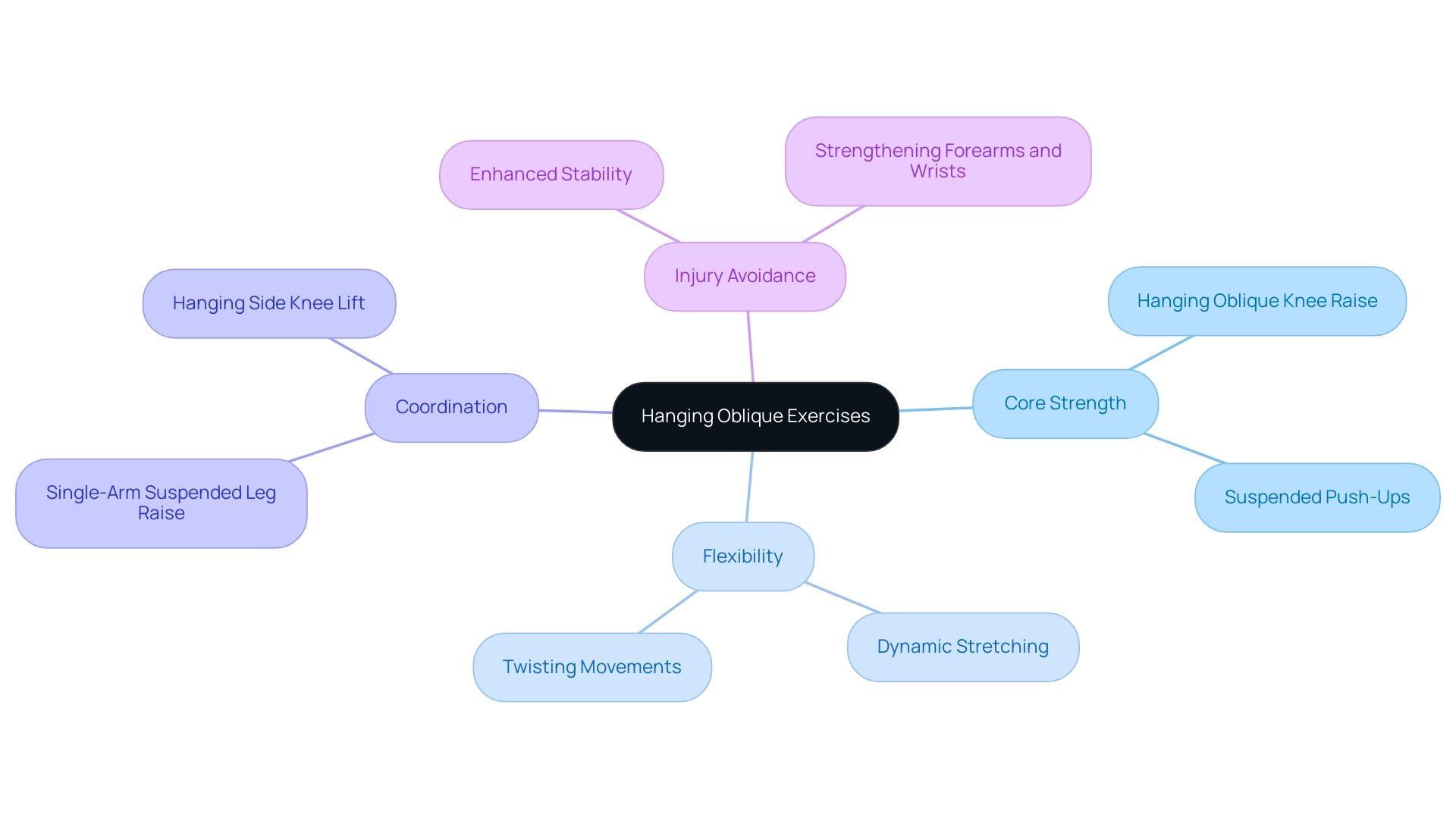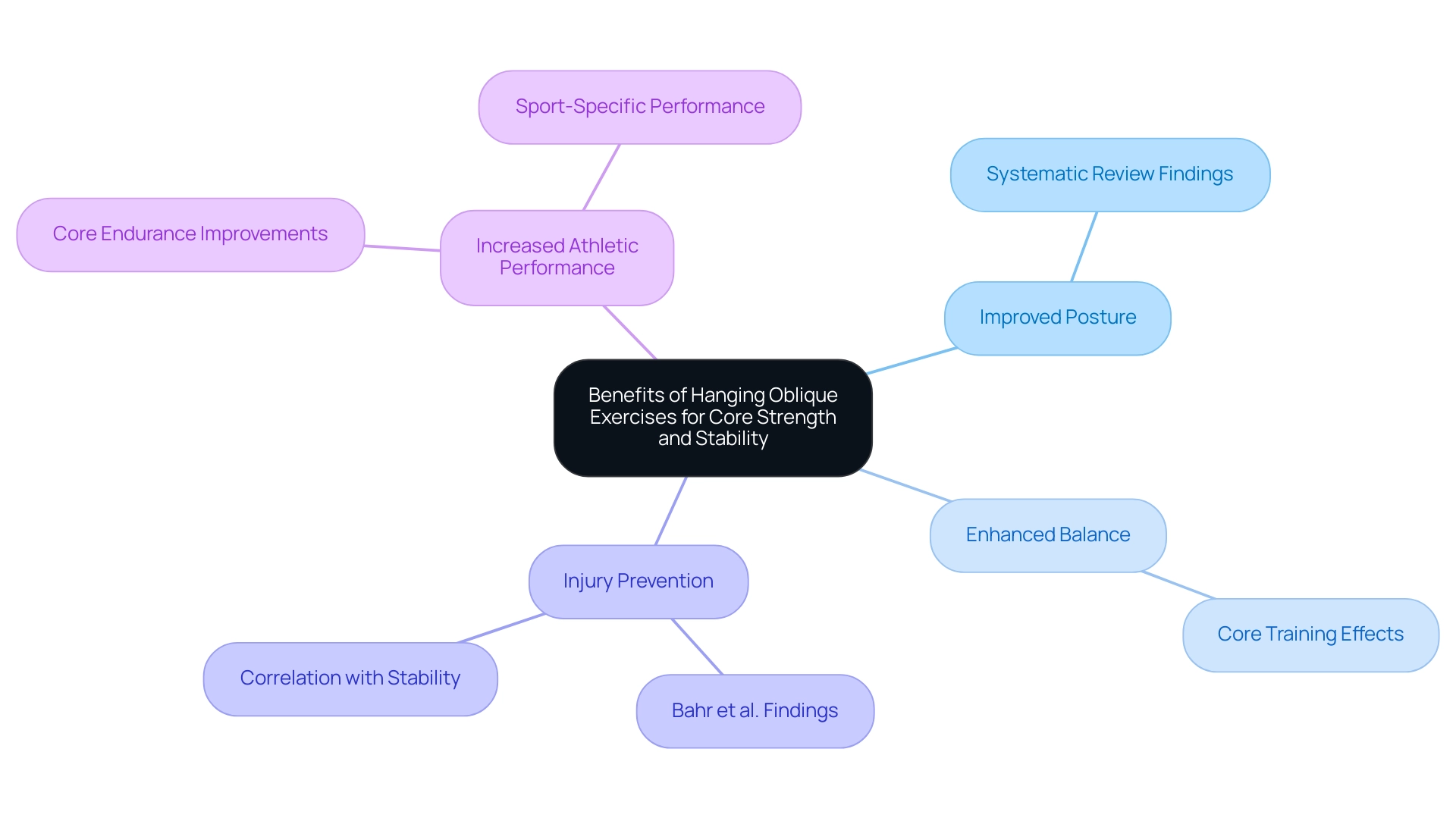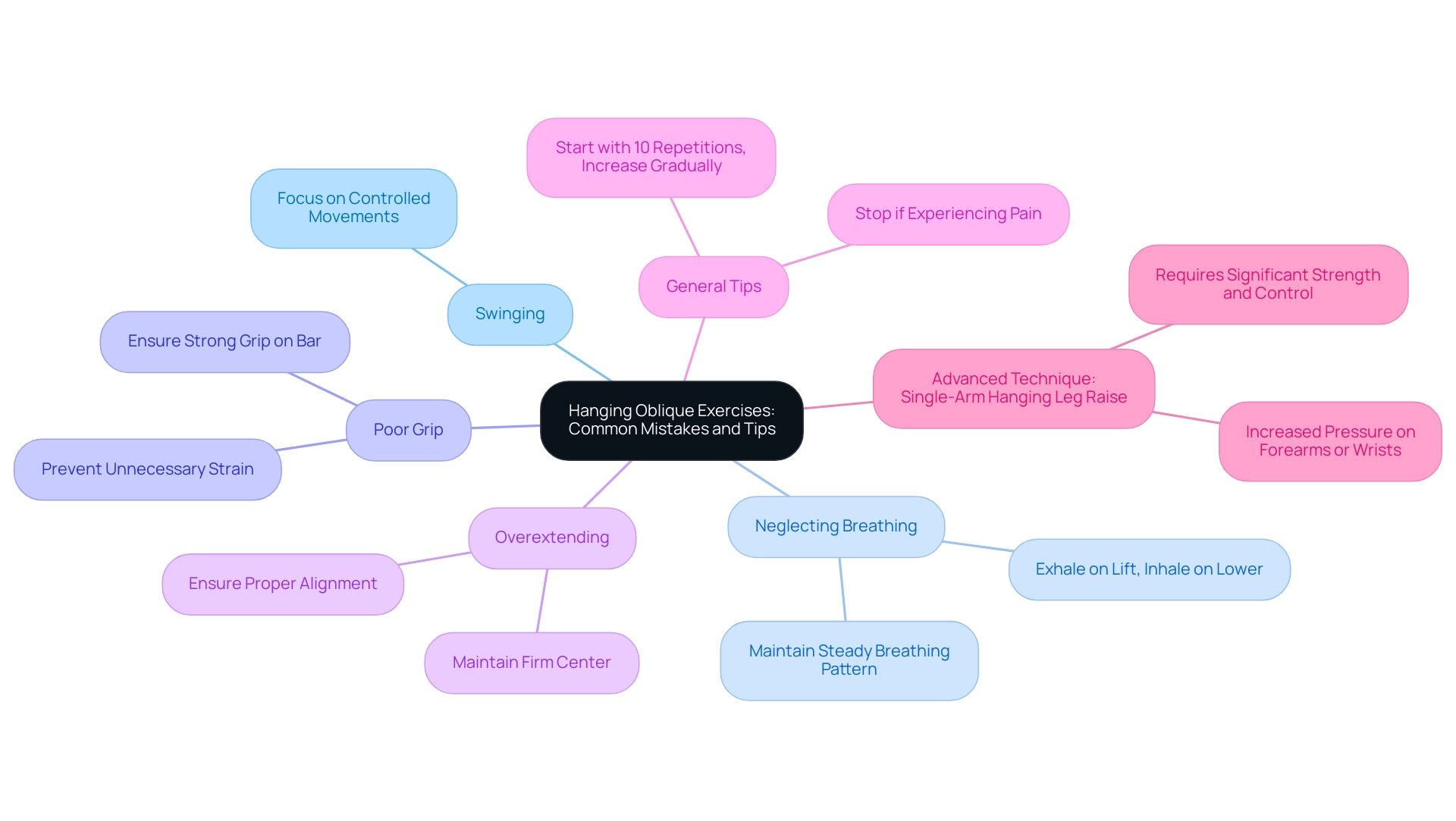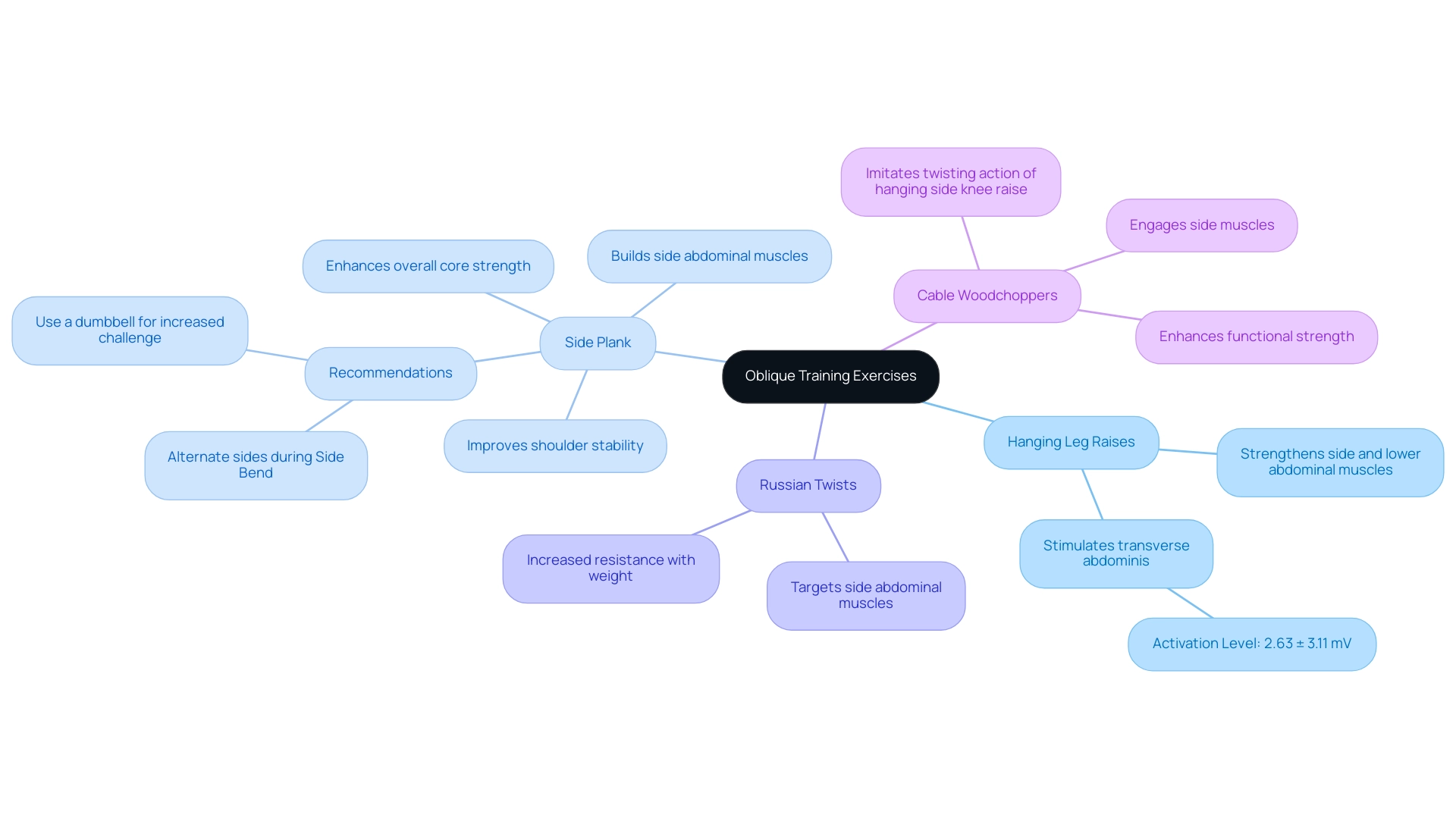Introduction
In the pursuit of a strong and stable core, hanging oblique exercises emerge as a powerful ally. Among these, the hanging oblique knee raise stands out, combining strength, flexibility, and coordination into one dynamic movement. This exercise not only targets the often-overlooked oblique muscles but also plays a critical role in enhancing overall athletic performance and injury prevention.
As organizations increasingly recognize the importance of employee well-being, integrating such effective exercises into fitness regimens can transform workplace culture, promoting health and resilience. By understanding the mechanics and benefits of hanging oblique exercises, teams can unlock their potential and foster a proactive approach to fitness that resonates beyond the gym.
Introduction to Hanging Oblique Exercises: The Hanging Oblique Knee Raise
Hanging oblique exercises are an outstanding technique to activate the side muscles, which play an essential role in maintaining core stability and overall physical strength. Among these workouts, the suspended side knee lift stands out as one of the most effective. This dynamic movement involves hanging from a bar while lifting the knees toward the chest and adding a twisting motion to effectively engage the side muscles.
Not only does this activity fortify core strength, but it also improves flexibility and coordination, essential components of functional fitness. Research highlights that the activity levels of the rectus abdominis (RA) and external muscles significantly increase during such suspended movements. As noted by Byrne et al., 'RA and EO activity levels increased on suspended front planks,' underscoring the effectiveness of these movements.
Additionally, a study by McGill & Marshall (2012), which involved male participants aged 25.60 ± 3.40 years, offers demographic context that bolsters the case for these activities. Grasping the mechanics of hanging oblique exercises is essential; it not only fortifies the midsection but also facilitates enhanced athletic performance and injury avoidance. Furthermore, the Single-Arm Suspended Leg Raise case study demonstrates a sophisticated use of suspension movements, highlighting how it necessitates being supported by one arm, which may impose extra strain on forearms or wrists, yet effectively tests stability in the abdominal region.
By incorporating these activities into your team's fitness routine, you can cultivate a culture of wellness that encourages overall health and resilience.

Benefits of Hanging Oblique Exercises for Core Strength and Stability
Suspended angled movements, particularly the suspended angled knee lift, are essential for improving abdominal strength and stability. Hanging oblique exercises specifically focus on the oblique muscles, contributing significantly to improved posture, balance, and overall function. A strong foundation is essential not only for daily activities but also plays a critical role in preventing injuries, particularly in environments where physical strain is prevalent.
Current research highlights a strong correlation between fundamental strength and injury prevention, with findings indicating that a stable center can mitigate the risk of lower extremity injuries, as noted by Bahr et al., who stated,
The results of this systematic review provide preliminary evidence for the association between impaired stability measures and the development of lower extremity injuries in healthy athletes.
Furthermore, enhanced central strength is linked to improved athletic performance and can elevate mental well-being by fostering greater confidence and motivation. A systematic literature review on central training evaluated the effects across eight randomized controlled trials, revealing that this training significantly improved stability and balance.
The high correlations between handheld dynamometry (HHD) tests and stationary dynamometer tests, ranging from r = 0.65 to 0.86, further support the reliability of these measurements. Integrating hanging oblique exercises into fitness routines not only enhances physical abilities but also promotes a proactive stance on wellbeing in the workplace.

How to Perform the Hanging Oblique Knee Raise: Step-by-Step Guide
Executing the suspended angled knee lift is an excellent method to enhance your midsection and boost overall fitness, essential elements of Foresight's all-encompassing health coaching services. As John R. Harry from Texas Tech University notes, "Ultimately, the use of simple and effective methods that are not restricted by group-based statistical assumptions can aid practitioners when conducting performance tests to determine athlete adaptations." This highlights the importance of practical approaches in fitness programs.
Follow these empowering steps to get started:
- Find a Suitable Bar: Locate a sturdy pull-up bar or overhead bar where you can hang comfortably; ensure it's secure and at the right height for you.
- Grip the Bar: Grip the bar with your hands shoulder-width apart, using an overhand grip. This positioning will provide stability and control.
- Hang Freely: Allow your body to hang freely, arms fully extended, while engaging your shoulders to prevent strain. This posture sets the stage for an effective workout.
- Raise Your Knees: Bend your knees and lift them towards your chest, twisting your hips to one side. This movement, including hanging oblique exercises, activates your side muscles, which are crucial for developing core strength and aligns with our personalized fitness coaching goals.
- Lower Your Legs: Gradually lower your legs back to the starting position, maintaining control throughout the movement. Focus on form to maximize effectiveness. Just as the case study on landing mechanics emphasizes the importance of clear phase definitions to prevent injuries, maintaining proper technique during hanging oblique exercises is vital to avoid strain.
- Repeat: Perform the desired number of repetitions, alternating sides to ensure balanced engagement of both obliques. Hanging oblique exercises are essential for overall core development.
Remember, incorporating this activity into your routine not only enhances your fitness but also sets a positive example for your team’s well-being. At Foresight, we believe tailoring activities to suit individual and environmental contexts produces the best outcomes, enabling your team to attain enduring lifestyle changes. Additionally, our app-based coaching delivery ensures personalized guidance and support, while our corporate memberships offer comprehensive wellness programs tailored to your organization's needs.
For more information on how we can assist you in implementing these techniques effectively, please reach out to us.

Common Mistakes and Tips for Effective Hanging Oblique Exercises
Performing hanging oblique exercises correctly is crucial for maximizing their benefits and minimizing injury risks. Here are some common pitfalls to avoid:
- Swinging: Relying on momentum can undermine the center's engagement. Instead, concentrate on controlled movements to genuinely activate your muscles.
- Neglecting Breathing: Maintain a steady breathing pattern throughout the activity; exhale as you lift your knees and inhale as they lower. This not only aids in performance but also enhances the mind-muscle connection, as emphasized by bodybuilding legend Larry Scott, who famously stated the importance of this connection in achieving optimal results.
- Poor Grip: A strong grip on the bar is essential for stability and control, preventing unnecessary strain.
- Overextending: Excessive swaying can compromise your form. Maintain your center firm to ensure proper alignment and avoid injuries.
Statistics show that many individuals neglect these essential factors, leading to increased injury rates associated with improper workout form. By recognizing these common mistakes and implementing these improvement strategies, you can significantly enhance the effectiveness of your hanging oblique exercises. For example, the Single-Arm Hanging Leg Raise is an advanced technique that requires significant strength and control; improper execution can lead to increased pressure on the forearms or wrists, making it essential to master foundational skills first.
Remember, if you experience pain, stop immediately and aim to perform 10 repetitions, gradually working up to 30 as your strength increases.
This approach not only promotes injury prevention but also cultivates a culture of safety and well-being within your fitness routine.

Variations and Complementary Exercises for Enhanced Oblique Training
To enhance your angled training routine, think about incorporating a range of dynamic movements that focus on these muscles more efficiently:
- Hanging Leg Raises: By raising your legs straight up, you work not only the side muscles but also the lower abdominal muscles, creating a thorough midsection workout. Significantly, movements such as the bird dog have been demonstrated to stimulate the transverse abdominis (TA) at 2.63 ± 3.11 mV, emphasizing the significance of core involvement in your routine.
- Side Plank: This effective activity not only builds the side abdominal muscles but also improves shoulder stability and overall core strength. It is recommended to switch sides during the Side Bend and consider using a dumbbell for added challenge, enhancing the effectiveness of this movement.
- Russian Twists: A fantastic seated activity that effectively targets the side abdominal muscles. Including a weight can greatly enhance resistance, boosting the advantages of this movement.
- Cable Woodchoppers: Imitating the twisting action of the hanging side knee raise, this activity provides a distinct angle of resistance, allowing for increased engagement of the side muscles and enhancing functional strength. According to Byrne et al., RA and EO activity levels increase on suspended front planks, which can further enhance your routine. By incorporating hanging oblique exercises into your training routine, you can foster a more balanced and impactful approach to oblique exercises, ultimately enhancing your team's fitness and well-being.

Conclusion
The benefits of hanging oblique exercises, particularly the hanging oblique knee raise, are undeniable. These movements not only strengthen the oblique muscles but also enhance overall core stability, flexibility, and coordination. By emphasizing the importance of a strong core, organizations can promote better posture and balance, crucial for both athletic performance and everyday activities. The link between core strength and injury prevention is clear; a stable core significantly reduces the risk of lower extremity injuries, empowering employees to remain active and engaged.
Incorporating the hanging oblique knee raise into fitness routines is a strategic step towards fostering a culture of wellness within the workplace. By providing clear guidance on proper execution, avoiding common mistakes, and exploring complementary exercises, teams can maximize the effectiveness of their workouts. Such initiatives not only improve physical health but also contribute to enhanced mental well-being, boosting confidence and motivation.
Ultimately, prioritizing core strength through exercises like the hanging oblique knee raise is more than just a fitness trend; it's an investment in employee health and resilience. Embracing these practices fosters a proactive approach to well-being that resonates throughout the organization, paving the way for a healthier, more productive workplace. Now is the time to take action and integrate these powerful exercises into team fitness regimens, unlocking the full potential of every individual.
Frequently Asked Questions
What are hanging oblique exercises?
Hanging oblique exercises are workouts designed to activate the side muscles, which are crucial for maintaining core stability and overall physical strength. These exercises often involve movements like the suspended side knee lift.
What is the suspended side knee lift?
The suspended side knee lift is a dynamic exercise where an individual hangs from a bar and lifts their knees toward their chest while adding a twisting motion to engage the side muscles effectively.
What benefits do hanging oblique exercises provide?
These exercises fortify core strength, improve flexibility and coordination, enhance athletic performance, and aid in injury prevention. They also contribute to better posture and balance.
How do hanging oblique exercises impact core strength?
Research indicates that hanging oblique exercises significantly increase the activity levels of the rectus abdominis (RA) and external oblique (EO) muscles, which are vital for a strong core.
What is the significance of the study by McGill & Marshall (2012)?
This study provides demographic context for the effectiveness of hanging oblique exercises, involving male participants aged 25.60 ± 3.40 years, and supports the notion that these exercises can enhance core stability and athletic performance.
How do hanging oblique exercises contribute to injury prevention?
A strong core, developed through these exercises, can mitigate the risk of lower extremity injuries. Research suggests that a stable center is crucial for reducing injury risk in physically demanding environments.
What additional benefits are associated with enhanced central strength?
Enhanced central strength is linked to improved athletic performance and increased mental well-being, fostering greater confidence and motivation in individuals.
What does the systematic literature review on central training reveal?
The review evaluated the effects of central training across eight randomized controlled trials and found that it significantly improved stability and balance.
How can hanging oblique exercises be integrated into fitness routines?
Incorporating these exercises into fitness routines can enhance physical abilities and promote a culture of wellness and proactive health management in the workplace.

